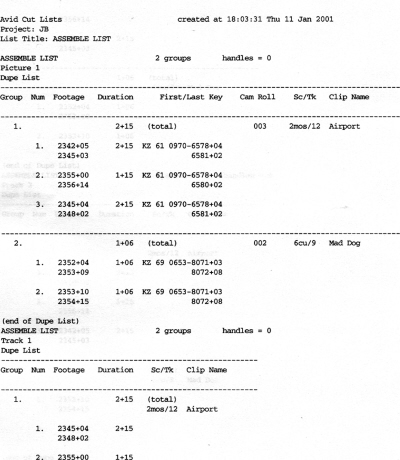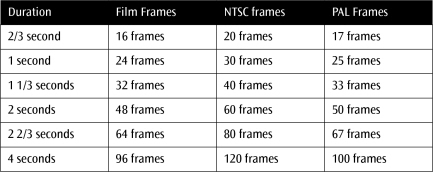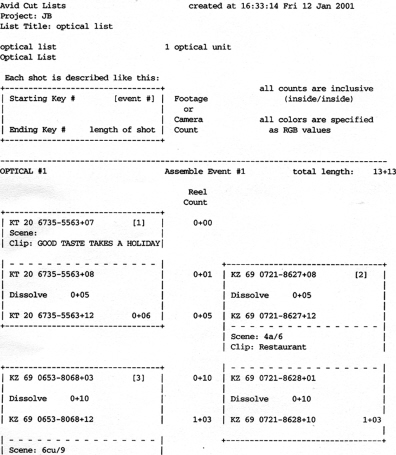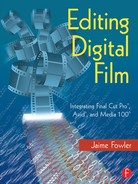A cut list is a printed version of the edit decisions. It contains key or ink numbers, time code from the master videotape edit, and information about the original camera and sound rolls used in the cut. Cut lists are normally used for picture only, unless the audio is transferred to mag stock and ink numbered. For audio, an edit decision list (EDL) is assembled using SMPTE time code as a reference. There are two common reasons to create a cut list: to conform a workprint, or to send to a negative cutter.
Negative Cutters
If the editor is not experienced at negative cutting, he or she will have to send a cut list out to another person. One of the basic principals of working on a motion picture is that if something goes out, it must have paperwork, and lots of it. Be sure to include as much information as possible for a neg cutter when sending out your cut list. This can include a digital cut of the edit on a videotape for confirming the cut points, reel continuity reports, editing notes, and so on. The more information the neg cutter receives, the more likely he or she will be to accurately recreate your edits. An editor should never assume that a neg cutter knows how he or she works.
A less often used but far more sensible approach is to actually call or even visit the neg cutter before the goods are delivered. It isn’t always possible, because the neg cutter may be in another city or even a different country, but even an email is good. Get to know this person. Know how the neg cutter works, what his or her preferences are and how they intend to complete the incredible task of finishing the film. Creating dialog with the neg cutter does two things for the film: it shows the neg cutter that you’re not just another pretty negative and it emphasizes the understanding of the importance of their role.
Okay, I can hear some of you laughing. But everyone needs a pat on the back now and then, right? Why not show a little attention to the most important person on your film? Remember, the hand that cuts the OCN is the hand that rules the world! Neg cutting is a thankless and unforgiving job. This person is required to properly perform physically all of the cuts completed on the NLE. One false slip and POW! The film is ruined. If the neg cutter seems nervous, that’s probably a good sign.
Types of Cut List
There are several different types of cut list, each of these lists corresponds to a particular need of a film.
The Assemble List
The assemble list, also known as a cut list, is a list of the cuts made on the film in the order in which they will be assembled. It starts with the first cut and ends with the last. Assemble lists can be customized to include several bits of information, depending on the software used to generate the list. At a bare minimum, every assemble list needs the following:
Starting key number
Ending key number
Duration (feet + frames)
Time code in (from the video master)
Time code duration
Camera roll
Scene and take
I like to include just about everything possible in my lists in order to minimize mistakes. Those things can include a description of the cut and any comments added during post production. These things are all important to me if I am using the cut list to conform a workprint.
Frame Handles
When the software is set up to output an assemble list, notice that there is an entry for “handles.” The handles for a cut list are the numbers of additional frames of film required to make a cut. If a workprint is being conformed, no handles are necessary. The frame is cut in between frames and will not overlap to any additional frames. However, if the list is being sent to a neg cutter, check to see how many frames they’ll need as handles. Most neg splicers require at least a single frame. I’ve dealt with some neg cutters who request as many as three extra frames on each side of the cut.

Figure 5.1 An assemble list
Why are handles so important? Neg cutters often use splicers that cut through the center of the next adjacent frame to the cut. If that next frame is needed elsewhere, they need to know that a duplicate is necessary before the cut is performed. Otherwise, the frame will be cut in half, rendering it unusable.
If there is any repetition of footage in a film or handles that overlap in the assemble list, a dupe list is mandatory. For a neg cutter, the dupe list is the first order of business. The neg cutter sends the neg to the lab to duplicate any frames that are used. A dupe list should be created even if the editor believes that there are no dupes in the picture. Remember, there is no such thing as “oops” in the world of neg cutting. A dupe list typically consists of the starting key number, ending key number, duration (feet + frames), time code in (from the video master), time code duration, camera roll, and scene and take. Other items can be added as well, depending on what the software permits.

Figure 5.2 A dupe list
The next list is called an optical list. Here we enter the world of A/B strand conforming. Here’s a rule of thumb: if the film is 35mm, it is almost always an A strand conform. If it is 16mm, it can be conformed A/B.
The advantage of A/B strand conforming is that the film can use two strands to be conformed. In other words, optical prints of certain dissolves can be avoided by merging the two strands. For example, in the case of a dissolve, the lab can print it by irising down the camera on the “from” source on strand A while irising up the “to” source on strand B incrementally. In order for this to happen, the dissolves must be lab standard durations. Lab standard dissolves normally include durations of 16, 24, 32, 48, 64, and 96 frames. Any other length will have to go to an optical printer. I mention this because optical printing is very expensive. Many inexperienced indie directors appreciate this little tidbit. Changing some of the dissolve durations by a few frames can make all the difference in the world to the budget.
Table 5.1 Lab standard dissolves

Standard opticals are dissolves, fade-ins, fade-outs and superimpositions. Fade ins and fade outs are also A/B strand capable at lab standard durations. Again, any other duration would make the fade an optical. Superimpositions are different, however. A superimposition, unlike a dissolve, mixes between two sources and holds the mixed image for a duration, before either cutting away or fading out one or both sources.
Titles from any NLE will have to be made by a titles or opticals company, unless the project is a DV film. Even then it is recommended, due to resolution limitations of video, that an optical be created. Even in the case of DV to film, a title over black would be better produced as a separate film optical.
A typical optical list will show key start and end numbers for the from and to sources, with a frame count for the duration. Many neg and workprint cutters prefer an optical list format called optical blocks. The block format makes it easier to identify the from and to sources, with the from source on the top portion of the block and the to source at the bottom. By using a geometric shape, it is easier to identify which is which at a glance, rather than poring through the list to verify the information.

Figure 5.3 An optical list configured with optical blocks
Now that we’ve described the list, here is a warning: find an optical house that does excellent work. It’s easy to go with a low bidder and report to the director that the budget is saved. But a bad optical can be disastrous. If you’ve never done opticals before, consult with other editors and assistants, your lab, and your neg cutter. They know someone who can do a good job at a reasonable price.
The final type of cut list is called a pull list. Pull lists make it easy to conform both workprint and negative. The pull list will show the cuts in the film arranged in the order of the reel from which they originated, so that the person conforming can “pull” the clips. It is normally sorted by cam roll and then from lowest to highest key numbers so that the selections are cut incrementally, rather than having to go back and forth on each cam roll.
There are alternative types of pull lists as well. A scene pull list shows cuts arranged first in the order of scene, then arranged by their associated cam roll numbers. This list is very similar to a scene assemble list, which has the cuts sorted by where they first appeared in the assemble list.
Lok Box
Before sending a list to the neg cutter, you’ll probably want to also send a lok box video. A lok box is a digital cut or output of the film on tape connected to a film gang synchronizer. Before creating a lok box, separate the cut into built reels, as described in Chapter 4. It is advisable to put a time code burn-in on the tape of record master time code in addition to any other burn-ins that are already there. This makes it easier for the neg cutter to gauge duration.
The Avid Film Composer offers a very desirable option for neg cutters: a lok box output that is frame-for-frame accurate. This type of output prints only film frames to the tape, with no pulldown. The result, when played at normal speed, is cartoon like sound, because the picture is speeded up- no pulldown is added to create thirty frames from the original twenty-four frames. The advantage of this frame-accurate output is that the neg cutter can jog through it and get an accurate accounting of each frame.
Conformed Workprint
Although a lok box video is an adequate visual representation of the film, nothing works better than a conformed workprint. The frame-for-frame accuracy and synchronized sound answer any questions that a neg cutter might have. Although it’s more expensive and time consuming, a conformed workprint not only tells the neg cutter the numbers, but shows them the numbers, complete with grease pencil and red audio markings. It’s more difficult to mistake intentions when a positive of the film is already assembled for reference.
When sending the lists to a neg cutter, be sure of two things. First, discuss the project with the neg cutter in full, learn all of his/her needs and output lists that conform to the neg cutter’s way of working. Second, have a phone nearby. If there are any questions, they’ll need to be answered immediately. Between the cut lists, a lok box, and a conformed workprint, the neg cutter should have all she or he needs. But there are occasions when questions come up. Availability is important in order to expedite the neg cutting process.
